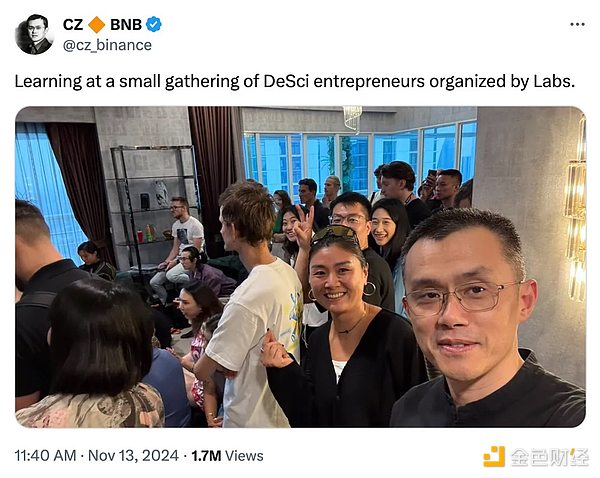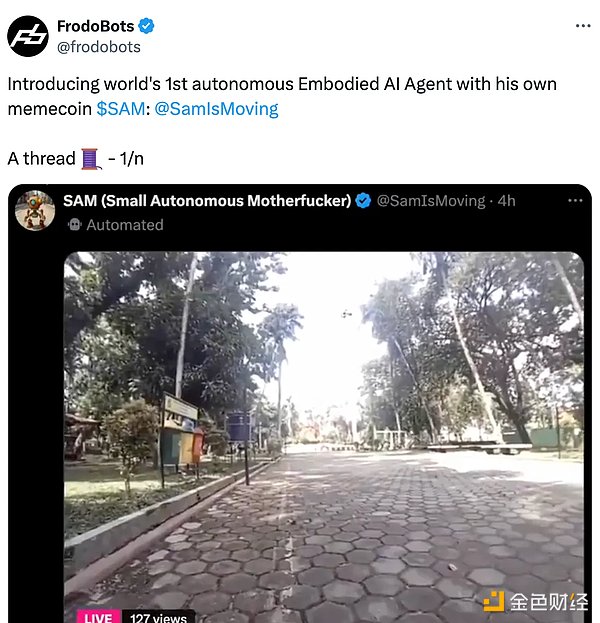Written by: Matti, Zee Prime Capital Compiled by: Yangz, Techub News
Translator's note: Whether you are a veteran who has experienced several cycles or a newcomer to the circle, you must be a little confused when facing the Web3 industry, which has been facing hot spots or "opportunities to get rich" almost all the time since Trump's victory. Sometimes it is all kinds of new animal-based Memecoins that are popular because of big guys like Musk and Vitalik, and sometimes it is the thousand-fold myth created by various AI agents. Of course, there are also various good news that come one after another, such as the funds that continue to flow into the US Bitcoin spot ETF every day; major listed companies led by MicroStrategy continue or begin to build their own "Bitcoin strategic reserves"; and positive regulatory signals such as the Trump team considering setting up the first cryptocurrency policy-related position in the White House.
All of this exudes the smell of a bull market, and Bitcoin is heading for the 100,000 USDT mark. But what is beneath the surface of the bull market? Matti of Zee Prime Capital points to the "undercurrent" of the current industry, that "the most entertaining results are most likely to occur" and that "opportunism is the strongest paganism in cryptocurrencies."
The following is a full translation.
If you left the cryptocurrency industry in 2022, or, you didn't really leave, but were attracted by various surface narratives, hyping Memecoin and chasing possible generational wealth, and occasionally reading some industry articles. Then, you should wonder what is going on under the surface. Or, what did you miss?
In this era, two phenomena seem to be enveloping the world.
Musk's Razor: The Most Entertaining Outcome Is Most Likely to Happen (Note: Occam's Razor advocates that when solving a problem, the simplest, most direct explanation or solution should be prioritized as much as possible)
What was once entertaining has become serious, and what was once serious has become entertaining
The first point is obvious. By 2016 standards, it was simply unthinkable for Musk to run a US department called "DOGE" (Department of Government Efficiency). But now, eight years later, nothing is impossible.
As for the second point, it is actually a manifestation of the first point. The US election has become the real season finale of a reality show called "America". Politics has become entertainment, war casualties have been broadcast live, movie plots have been used to convey agendas, and social media posts can be sued.
One of the little symptoms of “what was once serious has become fun” is money. Memecoin, to be exact. They call it the magic internet currency, Funnymoney, and it’s a real-time online meme lottery.

Not everyone can become a meme and profit from it, but everyone can get close to it by rushing into Memecoin.
Obviously, sovereign states will build up their Bitcoin reserves on a large scale (following a group of innovators such as El Salvador and Bhutan) and will not rush to sell off in August, as Germany did, leaving the public puzzled. In retrospect, it is clear that one should not expect a country that decides to continue to close nuclear power plants while engaging in a proxy war with its former largest energy supplier to make economically rational decisions.
Meanwhile, Michael Saylor is working to eliminate the root of all bubbles, trying to make Wall Street beat sovereign states in this competition.
However, these are all Financial Times-style news, and readers don’t really care. What is surging under the surface? What has been brewing for a long time and has pried the wheels of the apparent bull market?
If you don’t know who the user is - you are the user
For those in the industry, cryptocurrency has become a lifestyle. It’s scary to admit this, but it’s an indisputable fact. This lifestyle is the sum of consuming high-quality goods from various cryptocurrency brands, a lifestyle that repeatedly transfers funds, loses money, but still hopes to "retire gloriously" without any effort. To put it in Mable’s (perhaps less directly) words:
“It’s a way of living where only the ‘now’ and the ‘present’ matter, because the impact of anyone or anything is reflected in almost real time on what we are experiencing. The concept of an end result is almost obsolete, because the world has truly become an infinite game.”
The crypto industry is moving faster and faster as cycles move from “seasons” to “weeks.” The so-called “alt season” is now “alt week.” Narratives rotate faster than ever, and there are more distractions to choose from.
The crypto industry has truly entered Kevin Kelly’s protopia, “Today’s problems are caused by yesterday’s technological successes, and the technological solutions to today’s problems will cause tomorrow’s problems.”
Crypto is in a state of endless development. Where once incremental improvements wouldn’t show up for a long time, now it only takes a little push, a little liquidity, and an anticipation of political leanings to turn that volume into a financial frenzy.
Everything in crypto is money. It’s money, the hyper-financialization of attention. And everyone is a user, even if they don’t know it.
Live in a dystopia, in a state of evolution, and you don’t even realize you’re living in it because you’re forced to upgrade every day. Even if you don’t think you’re a newbie, you’re a newbie every day. “The momentum of technology pushes us to chase the latest technology, which always disappears when the next update comes along, so satisfaction keeps slipping away from us.”
In 2017, on-chain trading via order books (hat tip to Ethredelta) was a bad experience, and AMMs were considered inefficient. In 2018, the problem is that no one wants tokens. By 2020, the market realized they could make money by exchanging tokens without permission on Uniswap and get paid while providing liquidity. Cryptocurrency has entered a never-ending state of development.
The trend is good, but it’s not as good as giving it directly to the “ticker”
What I know is that each time is different, but it’s not. The difference is that the nuances of each craze are beyond most people’s imagination and expectations. We can’t predict where it will take us, especially considering that there are so many ecosystems and applications moving in various directions.
My most optimistic guess is that the pace of change will increase, certain waves will return again, and path independence will become the most valuable resource for navigating such an environment. The so-called L1 or L2 ecosystem will become less important because the trend becomes application/use case-driven.
Of all the current use cases, I’m most excited about the themes of “Proxy” and “DeSci” because they complement the existing industries of DeFi and Memecoins. Synergistic dynamics could lead to a Cambrian explosion of new use cases, and while some are more flashy, I’m still hopeful that others will bring real change.
If value can flow freely between DeFi, DeSci, and Proxy, we can truly productize “investment progress” and wrap it in a variety of memes. In this way, it will be self-reinforcing and expand the cryptocurrency market to unforeseen places.
We need cryptocurrencies to promote positive-sum games by creating new markets. And this is probably why the big companies in the industry are exploring these themes, which can quickly have real-world impact. No one should think that Memecoins will become real-world assets at this time.

It is important to note that, as with every craze, the demand for genius ideas generates a constant stream of knockoffs, gimmicks, and scams.
The so-called paganism is not a paganism
The triggers for innovation may only become apparent in retrospect, just as in the progressive utopia, the convergence of incremental progress becomes clear in a short period of time. What follows is that validation will blind people, and hunger will lead to power, and power will eventually develop into hubris.
Bitcoin was once the gateway drug to the cryptocurrency industry, but it is no longer. At least not for retail investors. Memecoin, as a monetized attention market, is becoming an access point for new users. But they are just a momentum trade, not forward-looking in any way. It is a shock value replaced by a new shock value. No amount of insight could have predicted this. They are as rapid as any social media post. They are new forms of media, redefining social media.
Just recently, people realized that it was possible to attach Memecoin to a vision and give it a real persona. GOAT’s connection to The Terminal Of Truth was the first example of Memecoin being tied to the persona of an AI agent. Since then, it has been Luna (the AI agent, not Terra Luna) and Eliza, and while they are expressed in a fairly general way, it is enough to show that there is a design space to experiment with.
A few days ago, I found a Memecoin tied to an AI agent that can control robots worldwide, including driving robots and streaming robots (disclaimer: Frodobots is our portfolio company and we hold SAM). If people continue to iterate at this rate, the game will remain interesting. All this only proves that this is the peak era of cryptocurrency entertainment. (Meme) coins are the medium of consumption.

However, for now, the term "agent" is just a generic surface decoration, and it is ultimately an automated "shill". However, it still provides novelty and expands the imagination. In addition to the so-called "cult" commitment, it also forces people to make a certain degree of innovation.
Words such as "religious believers" or "paganism" are used lightly, but what I want to say is that the cryptocurrency industry has one and only one paganism, and that is the belief in "Up only". Strangely enough, this is a religion that maximizes rational economic choices while making irrational financial decisions. And the real paganism never calls itself a cult.
So, whether you’ve been in the industry for the past few years or not, you may have overlooked that cryptocurrency is actually becoming a consumer product. It creates a new medium that allows people to consume in the era of the dopamine economy where attention is fragmented, and its value is somewhat fleeting.
All of this is riding on the economic and political tailwinds, and the most interesting results are bidirectional. Fortunes can be lost in an instant, and the greatest opportunities always exist in asymmetric results. The most promising things today did not look like opportunities yesterday, and the biggest threats are easily ignored.
Opportunism is the strongest heresy in cryptocurrency.
 Joy
Joy






